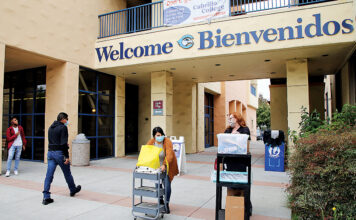What’s with the forlorn old palm tree at Platforms Beach? At the end of Beach Drive just before the gate, it stands in a sad pile of ice plant and weeds in front of the bathrooms at the State Beach parking lot. It is the last remaining sentry from the garden of the finest watering hole on the west coast, the Rio Del Mar Beach Club.
Both Seacliff and the Rio Del Mar developments were severely impacted by the depression which started in 1929, the same year the Rio Del Mar Hotel opened. By 1931, the developers of Seacliff had relinquished their beach to the state. But, the two remaining developers of Rio Del Mar, Leo Monroe and Larry Miller, had deeper pockets and were able to weather the storm. After Prohibition was repealed at the end of 1933, plans were made to expand the hotel, add a casino and a beach club. Benjamin Schreyer, a San Francisco architect and brother-in-law of Larry Miller, was hired to make it all happen. The initial idea for the Beach Club was for a large, two-story building, similar to the golf lodge with lodging upstairs. But when Schreyer took over, it became a modern, art deco affair, a new look with new promise.
In September of 1935, workmen cleared the brush and leveled the ground with teams of horses. The road was relocated behind the proposed club. Rio del Mar had their own mill producing lumber for the forms and finish materials. The contract was let in April of 1936 to Lindgren and Swinerton of San Francisco. Original cost estimates of $40,000 quickly escalated to $62,000 by completion. Construction was estimated to take two months, to be open by July 4, but ultimately took five months.
The clubhouse was reinforced concrete, 174 feet long, built on a concrete platform. It had a composition roof and translucent glass tile blocks in the locker rooms. There were indoor and outdoor dining rooms, a bar, an office, a lobby, a complete kitchen, 400 lockers, a large tile shower room, a heating plant, and employee’s quarters. The “platform” rested upon large mushroom-shaped concrete piers driven into the sandstone below the beach. The piers supported a huge concrete slab, six inches thick, four feet above the beach. The foundations were billed as “impervious to wind or wave.” That was just asking for trouble.
In August 1936, interior design and furnishings were handled by Miss Genevieve Butler of New York City, well-known for similar work at Florida beaches. Miss Butler promised one of the most beautiful beach clubs in America.
The walls were golden and Fredrick Young did mosaic style murals of pastel squares ranging from yellow to aquamarine. The club also boasted the first Formica installation in the state, including the bar, wainscoting, yellow table tops and the locker room walls. The dining furniture was constructed of rust-proof galvanized white metal. There were wicker easy chairs with cushions of butter yellow and sky blue leather, or bright heavy fabric, with wicker occasional tables. The flush mounted, modern, indirect lighting fixtures were by John Otar. Clever penguin murals were painted on three walls in the main room by Fred Deveret of San Francisco who also painted the murals in the main hotel. Heavy blue and white woven drapes softened the effects of the venetian blinds, making the large room cozy and intimate. Metal tables with comfortable director-type chairs adorned the outdoor terrace.
The grounds about the Beach Club were landscaped with full grown plants which had been moved from the hotel grounds in order to make room for the new additions to the hotel which included a new dining room, dance floor, kitchen and 18 additional rooms.
The Beach Club had 1,000-foot beach frontage which was fenced. They intended to provide every type of beach recreational facility, with the portion of the beach in front of the club built up for volleyball and badminton courts. A door man greeted attendees to make sure the facilities were only open to members and their guests. The Beach Club informally opened Sept. 5, 1936, at 8 p.m. Club hours were reduced to weekends in October. The Club officially opened daily for the season on Feb. 22, 1937, Washington’s birthday. This became the annual opening date. The menu consisted of salads, sandwiches, short orders from the grill, including eggs Benedict, and dinners. Initially, picnicking was not allowed in order to keep the private beach immaculate and to prevent bees.
Besides a doorman, the staff included a chef, a bartender, a number of beach boys to serve the guests, and a masseur in the locker rooms. The price for a full Swedish massage was $1.
Two rafts were anchored off the beach for swimmers and a life guard was on duty whenever the club was open. The Country Club boasted that “government statistics show this section of beach is one of the two safest beaches on the Pacific coast.” Additionally, by summer of 1937 the beach was being advertised as “the cleanest and safest on the Monterey Bay. It is clear of kelp and seaweed. There is no riptide nor undertow and the sands are kept as clean as a scoured floor.” Promises are made to be broken and in February of the next year, although there was very little seaweed elsewhere, it was stacked four feet high immediately in front of the Beach Club for a distance of about 50 feet, each wave adding to the height of the piles. In April, the beach had to be cleaned of an unusual amount of driftwood. During the same month, three swimmers were pulled from the surf after encountering trouble while two exhausted swimmers trying to rescue them also had to be assisted from the water.
As we know, winter storms are not always kind to our beaches. In January 1939, tides swept across Beach Drive several times piling sand on the concrete surface. Shrubs planted about the Beach Club were undermined. In January 1940, high waves washed out the flower bed and many valuable plants were lost but no damage was done to the building. In October 1940, enormous ground swells and huge waves sent water under the Beach Club and over the retaining wall onto Beach Drive, and in December, high rollers washed completely around the beach club. The beach was covered with logs, and the ramps were taken in as the sand had been washed out deeply adjacent to the club. The concrete foundation and piling foundation of the Beach Club was entirely exposed to the waves. The club was closed for the winter.
During the Beach Club’s heyday, a program was set up to entertain children on the beach each Thursday from 10 a.m. until 2:30 p.m. so that their mothers would be able to play golf. Evening beach picnics, bonfires, weenie roasts, and dances were held.
World War II was another blow to the Country Club. The Beach Club became a barracks for the Coast Guard. The Beach Club never recovered. The State of California purchased it in 1955 and added it to Seacliff State Beach as the Rio Del Mar unit. The main building was removed and given to a local nursing home (I would love to know where it ended up). The remaining locker rooms and bathrooms were kept as a comfort station until 1966 when they were torn down. The current bathrooms were built in 1980 on a portion of the remaining concrete platform.
The developers of Rio Del Mar had grand dreams but all that remains are shadows of former grandeur and wonderful memories. If you like these stories, please consider a donation to the museum or why not become a member?











